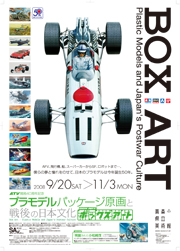Box-art of plastic models and Japan’s postwar culture
The plastic models give us the joy of creativity.
In the days of the high growth Japanese economy long before the boom of Video games, every single boy used to be immersed in assembling plastic models such as heavy tanks, airplanes, battleships, racing cars, and robots feeding their dream and imagination.
There sure is a small world in a plastic model.
Fifty years have passed since the first Japanese plastic model was rolled out.
The door to this small world for kids starts opening in the moment when they hold the package with illustrations called “Box-art” depicting the complete image of the model inside.
The Box art was originally designed to boost consumer interest.
It not only functioned as the package decoration but also gave a perfect image of the plastic model to the consumer.
In the early days of plastic models, citizens were still tied to the military image.
Therefore, people overlapped the military image with mighty cartoon heroes or imaginative movie monsters in the illustration of Box-art.
Box-art depicts the popular culture in each era.
We can see how culture evolved through Box-art.
In this exhibition, we introduce how Japanese plastic models were evolved.
Some old documents show that the wood models of military ship, airplane, heavy tank, were used as school teaching kits during the war.
In our research, we found those wood models were the fundamentals of Japanese plastic models and mighty military images inspired the draft designs of Box-art.
Our exhibition features the 164 original pictures of Box-art produced by four worldwide famous Japanese manufacturers, Tamiya. Inc, Hasegawa Corporation, Aoshima Bunka Kyozai Co.,Ltd, Bandai Co.,Ltd
As you look how Japanese culture changed in the passed fifty years through Box-art, you too might be drawn into 1960’s – 1970’s or the nostalgic mid-Showa era.
Along with Box-art, we also feature more than a hundred antique plastic models kits, and the completed diorama.
Through this exhibition, we aim to increase people’s understanding and appreciation of the history of Japanese pop culture.
Please enjoy this essence of Japanese pop culture.
Aomori Museum of Art
| Address | 185 Chikano, Yasuta, Aomori, Aomori, 038-0021, Japan |
|
| TEL | 017-783-3000 | |
| bijutsukan@pref.aomori.lg.jp | ||
| Access | (JR) 20 minutes by car from JR Aomori Station (Aomori Municipal bus.) 20 min. by bus bound for “MENKYO-CENTER via Art Museum” from JR Aomori Station.The Bus Stop “Kenritsu-bijutsukan-mae” (Airport) 20 minutes by car from the Aomori Airport. (Highway) 5 minutes by car from the Tohoku Expressway Aomori Interchange
|
Details
Period
42days
2008/9/20 (SAT) – 2008/11/3 (MON)
Hours
9:30 – 17:00
Close
2008/9/22 (MON) ,10/14 (MON) ,10/27 (MON)
Admission
Special exhibition + Aleko Hall (*)
Adults / 1,300 (1,000) yen
High School & College & University / 800 (500) yen
School children & Junior High School / 500 (300) yen
Special exhibition + Collection Gallery
Adults / 1,700 (1,400) yen
High School & College & University / 1,100 (800) yen
Schoolchildren & Junior High School / 600 (400) yen
Exhibition Structure
Co-exhibition : A found artist Shigeru Komatsuzaki - Original Box-art illustrations in 1970's.
Shigeru Komatsuzaki (1915-2001) was an painter and illustrator who had a huge impact on the postwar Japanese pop culture.
His works grabbed the hearts of many children and opened their eyes to pop culture through his illustrations in a magazines or Box-art packages.
In those days, he usually depicted a scene from a dynamic military history or a science fiction movie.
In 1961, he secured his job in Box-art by the legendary plastic model “Pantzer Tank”, and broadened his reputation to others.
He not only sustained a boom of plastic models in 1960′-1970′ but also broadened the horizons of Japanese pop culture.
This co-exhibition which focuses on artist Komatsuzaki features his original forty illustrations from big hit TV program serials “Thunder Bird”, “Ultraman”, “Masked Rider”, “Mazinger Z”, etc.
All these original illustrations were recently discovered in Bandai Co.,Ltd storage for the first time after a few decades silence.
We hope you see how Komatsuzaki created a bridge between the past and present.
※To see this co-exhibition, you need an admission ticket of “Box-art of plastic models and Japan’s postwar culture”


